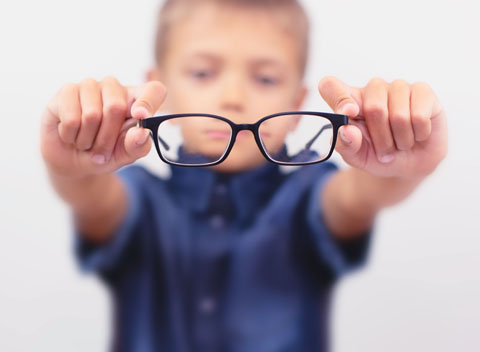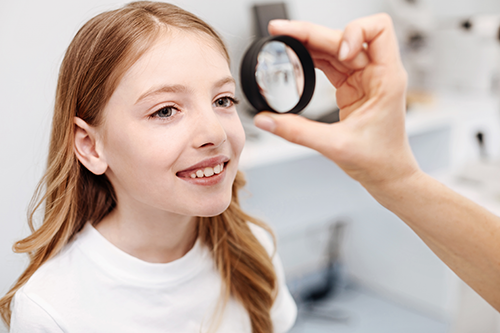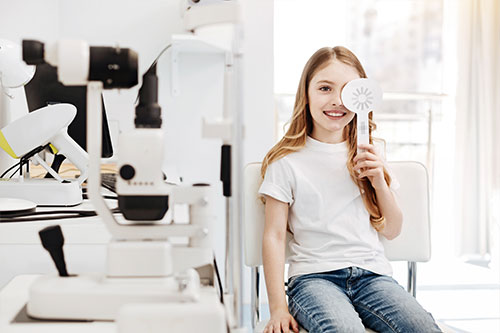Myopia Control
Myopia is the most common refractive error worldwide, and its prevalence is rapidly rising. A recent study estimates that almost 50% of the world’s population will have myopia by 2050. Untreated myopia can make many daily activities difficult, such as driving or watching TV.
prevalence is rapidly rising. A recent study estimates that almost 50% of the world’s population will have myopia by 2050. Untreated myopia can make many daily activities difficult, such as driving or watching TV.
WHAT IS MYOPIA?
 Myopia is a very common visual condition wherein children need glasses to see objects in the distance. It is also known as nearsightedness. This refractive error causes light to focus at a point just in front of the retina, making it difficult for the person to see distant objects clearly.
Myopia is a very common visual condition wherein children need glasses to see objects in the distance. It is also known as nearsightedness. This refractive error causes light to focus at a point just in front of the retina, making it difficult for the person to see distant objects clearly.
WHAT CAUSES MYOPIA?
Myopia occurs because of the shape of the eye. Why does the eye grow like this in the first place? Myopia is caused by a complex combination of genetic and environmental factors. While there is evidence that shows a hereditary component, symptoms of myopia can worsen due to various lifestyle habits. Reduced time spent outdoors and an increased amount of time spent on computer screens, phones, video games, and other digital devices may increase the risk of myopia.
Healthy outdoor activities, such as hiking, sports, or swimming, can preserve your child’s eye health while promoting an active lifestyle. It’s also essential to ensure they’re wearing sunglasses with proper UV protection to safeguard their eyes from harmful UV rays.
Myopia can easily be diagnosed during a routine eye exam. It’s essential that refractive errors are diagnosed and managed early. Children with undiagnosed vision problems often struggle in school.
MYOPIA SYMPTOMS
 Children are not always aware they have a vision problem, which is why regular children’s eye exams are so important.
Children are not always aware they have a vision problem, which is why regular children’s eye exams are so important.
You may notice your child exhibiting symptoms of a vision problem yourself. If your child shows any of the following signs, book them for an eye exam as soon as possible:
- Squinting
- Sitting too close to the TV or at the front of the classroom
- Excessive blinking
- Frequent eye rubbing
- Unaware of distant objects
- Headaches
- Complaining of blurry vision
YOUNGER EYES, FASTER PROGRESSION
Research has shown patients who develop myopia as young children tend to experience worse myopia than patients who develop this condition as older children or adolescents.
Onset age is one of the most important factors in determining how someone’s eyes are affected later in life.
Myopia can start developing in children as young as 3 years old. As it progresses, myopia can eventually start affecting how well they see and learn in school.
We recommend that your child has regular eye exams to help manage their symptoms of myopia. By detecting these issues early, your eye doctor can recommend a variety of solutions and make the visual adjustments necessary to help your child remain confident in their vision.
Moderate to high levels of myopia can lead to substantial vision loss due to lengthening of the eye which significantly increases the risk of retinal detachment, glaucoma, cataracts, and macular degeneration. By allowing a child’s prescription to change unabated, we are putting their future vision at risk.
HOW TO SLOW DOWN MYOPIA PROGRESSION
While there is no cure for myopia, there are management options available to help keep your vision clear and slow down myopia progression. One is optically; using contact lenses and or glasses. The second option is pharmaceutical or prescription eye drop therapy.
MYOPIA CONTROL OPTIONS
An initial consultation visit is recommended with both parents and the patient. A detailed discussion is conducted, it includes risk factor identification, the examination process, lifestyle questionnaire (including how much near work & outdoor activity they engage in per day/week), discussion of the results & development of a personalized treatment plan.
Myopia progression can be slowed using various control methods while the eyes are still developing. Some of the myopia control methods we may recommend are:
1. Multifocal Contact Lenses
Studies have found that myopic children experienced less myopic progression with the help of special contact lenses, specifically multifocal contact lenses. When wearing multifocal contact lenses, some children experienced slower progression, as well as slower axial length growth.
2. Eyeglasses
Bifocal or multifocal eyeglasses have varying degrees of lens power in each lens, typically with the lower half of the lens for near vision and the top for distance.
Specially designed optical lenses are also available that alter the focus of light from the periphery. New developments in this area now allow for prescription control similar to contact lenses or eye drops
3. Low Dose Atropine
Atropine has been used in eye care for over 100 years to help eye doctors view inside the eye and treat certain eye conditions. To control myopia, researchers have discovered that Low Dose Atropine can slow down prescription change by about 50%. Drops are taken once per day at night before bed.
At Focal Sight Myopia Care, our team of Ophthalmologist & Optometrists will create a customized myopia control program based on your child’s unique needs. We look forward to working with you to help control your child’s myopia. Please call us at (032) 415 1052 to see how our eye doctors can help protect your child’s eyes in order to see the world better!
